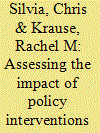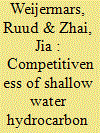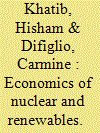|
|
|
Sort Order |
|
|
|
Items / Page
|
|
|
|
|
|
|
| Srl | Item |
| 1 |
ID:
149971


|
|
|
|
|
| Summary/Abstract |
The Fukushima-Daiichi Accident demonstrated the need of assessing and strengthening institutions involved in nuclear safety, including the accountability of regulators. There are a few problems hindering the path towards a greater understanding of accountability systems, the ensemble of mechanisms holding to account the nuclear regulator on behalf of the public. There is no consensus on what it should deliver and no systematic assessment method exists.
|
|
|
|
|
|
|
|
|
|
|
|
|
|
|
|
| 2 |
ID:
149957


|
|
|
|
|
| Summary/Abstract |
This article proposes that optimally deployed solutions to the intermittency introduced by high penetration solar – e. g., electrical storage, optimized curtailment and demand response – could affordably transform solar power generation into the firm power delivery system modern energy economies require, thereby enabling very high solar penetration and the displacement of conventional power generation. The optimal deployment of these high-penetration-enabling solutions imply the existence of a healthy power grid, and therefore imply a central role for utilities and grid operators.
|
|
|
|
|
|
|
|
|
|
|
|
|
|
|
|
| 3 |
ID:
150001


|
|
|
|
|
| Summary/Abstract |
China plans to reduce carbon dioxide emissions from 2005 levels by 40–45% by 2020 and by 60–65% by 2030. This research project addresses this challenge by analyzing Chinese provincial carbon dioxide emission efficiencies and the energy consumption structure. The study applies the Slacks Based Measure (SBM) model to analyze the data from 30 regions in China from 2000 to 2011. The situation of provincial carbon dioxide emission efficiency, the characteristics of the energy consumption structure in each province, and the differences among these provinces are quantitatively analyzed. Based on the K-means cluster analysis, this research suggests that China be divided into five groups in the energy consumption structure: the inefficient and less reasonable group, the inefficient and more reasonable group, the efficient and less reasonable group, the efficient and more reasonable group, and the efficient and most reasonable group. The study offers recommendations for the government to develop policies to effectively and efficiently reduce carbon dioxide emission levels for each group. It also has profound implications for government administration in developing countries to guide the energy consumption and to control environmental pollution for the healthy development of the economy.
|
|
|
|
|
|
|
|
|
|
|
|
|
|
|
|
| 4 |
ID:
150004


|
|
|
|
|
| Summary/Abstract |
To help overcome the challenge of growing CO2 emissions, China is experimenting with market-based instruments, including pilot CO2 emissions trading systems (ETSs) in seven regions that serve as precursors of a national CO2 ETS. Implementing an ETS in a rapidly growing economy in which government authorities exercise significant control over markets poses many challenges. This study assesses how well three of the most developed pilot ETSs, in Guangdong, Shanghai, and Shenzhen, have adapted carbon emissions trading to China's economic and political context. We base our study on new information gathered through interviews with local pilot ETS regulators and experts, analysis of recent trading data, and extensive legal and literature reviews. We point out instances in which pilot regulators have deftly tailored carbon emissions trading to China's unique context and instances in which designs are insufficient to ensure smooth operation. We also indicate areas in which broader institutional reforms of China's political economy may be required for carbon emissions trading to operate successfully. We make nine recommendations to improve the design and operation of the pilot programs and to inform the construction of a national CO2 ETS.
|
|
|
|
|
|
|
|
|
|
|
|
|
|
|
|
| 5 |
ID:
149986


|
|
|
|
|
| Summary/Abstract |
Heightened concern regarding climate change and energy independence has increased interest in plug-in electric vehicles as one means to address these challenges and governments at all levels have considered policy interventions to encourage their adoption. This paper develops an agent-based model that simulates the introduction of four policy scenarios aimed at promoting electric vehicle adoption in an urban community and compares them against a baseline. These scenarios include reducing vehicle purchase price via subsidies, expanding the local public charging network, increasing the number and visibility of fully battery electric vehicles (BEVs) on the roadway through government fleet purchases, and a hybrid mix of these three approaches. The results point to the effectiveness of policy options that increased awareness of BEV technology. Specifically, the hybrid policy alternative was the most successful in encouraging BEV adoption. This policy increases the visibility and familiarity of BEV technology in the community and may help counter the idea that BEVs are not a viable alternative to gasoline-powered vehicles.
|
|
|
|
|
|
|
|
|
|
|
|
|
|
|
|
| 6 |
ID:
150002


|
|
|
|
|
| Summary/Abstract |
National carbon mitigation policy included in the Clean Power Plan (CPP) targets electric power generation facilities and may have substantial impacts at the national level. The subnational impacts will vary because the level of dependence on coal for electricity generation varies substantially across states. Indiana represents a state where the CPP impacts may be relatively large due to heavy dependence on coal for electricity generation. Therefore, this paper presents analysis of the efficacy and cost of alternative approaches to carbon mitigation policy, taking Indiana as an example.
|
|
|
|
|
|
|
|
|
|
|
|
|
|
|
|
| 7 |
ID:
149992


|
|
|
|
|
| Summary/Abstract |
This article adds to the growing insight into public acceptance by presenting a novel approach to how citizens make sense of new energy infrastructure. We claim that to understand public acceptance, we need to go beyond the current thinking of citizens framed as passive respondents to proposed projects, and instead view infrastructure projects as enacted by citizens in their local settings. We propose a combination of sensemaking theory and actor–network theory that allows insight into how citizens enact entities from experiences and surroundings in order to create meaning and form a reaction to new infrastructure projects. Empirically, we analyze how four citizens make sense of an electricity cable project through a conversation process with a representative from the infrastructure developer. Interestingly, the formal participation process and the materiality of the cable play minor roles in citizens' sensemaking process. We conclude that insight into the way citizens are making sense of energy infrastructure processes can improve and help to overcome shortcomings in the current thinking about public acceptance and public participation.
|
|
|
|
|
|
|
|
|
|
|
|
|
|
|
|
| 8 |
ID:
150005


|
|
|
|
|
| Summary/Abstract |
This study investigates the long and short run relationships among carbon emissions, energy consumption and economic growth in India at the aggregated and disaggregated levels during 1971–2014. The autoregressive distributed lag model is employed for the cointegration analyses and the vector error correction model is applied to determine the direction of causality between variables. Results show that a long run cointegration relationship exists and that the environmental Kuznets curve is validated at the aggregated and disaggregated levels. Furthermore, energy (total energy, gas, oil, electricity and coal) consumption has a positive relationship with carbon emissions and a feedback effect exists between economic growth and carbon emissions. Thus, energy-efficient technologies should be used in domestic production to mitigate carbon emissions at the aggregated and disaggregated levels. The present study provides policy makers with new directions in drafting comprehensive policies with lasting impacts on the economy, energy consumption and environment towards sustainable development.
|
|
|
|
|
|
|
|
|
|
|
|
|
|
|
|
| 9 |
ID:
149998


|
|
|
|
|
| Summary/Abstract |
Based on the national greenhouse gas emission reduction target for 2030 (“GHG target for 2030″) and the 2nd Energy Master Plan (“2nd EMP”), several power mix configuration scenarios were tested to estimate the sensitivity of the carbon dioxide emissions and the ‘overshoot ratio’, which is the ratio of ecological footprint to biocapacity. It would be only possible to achieve the GHG target for 2030 if the fraction of non-emission energy be more than 70% of the total input primary energy for power generation with the current conversion efficiency (40%). Even the conversion efficiency is changed to 50%, still the carbon dioxide emissions are larger than the targeted carbon dioxide emissions from the energy sector. The overshoot ratio would still increase from 5.9 in 2009 to 7.6 in 2035 even with the successful implementation of the 2nd EMP. Thus, additional efforts to reduce the carbon dioxide emissions and the overshoot ratio from the energy sector are required beyond adjusting the supply mix configuration for power generation and the conversion efficiency. Policies and programs encouraging the changes in consumer behavior toward reduction of goods consumption and energy savings are expected to impact on reducing the carbon dioxide emissions and the overshoot ratio.
|
|
|
|
|
|
|
|
|
|
|
|
|
|
|
|
| 10 |
ID:
150014


|
|
|
|
|
| Summary/Abstract |
Climate change has become one of the most challenging issues facing the world. Chinese government has realized the importance of energy conservation and prevention of the climate changes for sustainable development of China's economy and set targets for CO2 emissions reduction in China. In China industry contributes 84.2% of the total CO2 emissions, especially manufacturing industries. Data envelopment analysis (DEA) and Malmquist productivity (MP) index are the widely used mathematical techniques to address the relative efficiency and productivity of a group of homogenous decision making units, e.g. industries or countries. However, in many real applications, especially those related to energy efficiency, there are often undesirable outputs, e.g. the pollutions, waste and CO2 emissions, which are produced inevitably with desirable outputs in the production. This paper introduces a novel Malmquist–Luenberger productivity (MLP) index based on directional distance function (DDF) to address the issue of productivity evolution of DMUs in the presence of undesirable outputs. The new RAM (Range-adjusted measure)-based global MLP index has been applied to evaluate CO2 emissions reduction in Chinese light manufacturing industries. Recommendations for policy makers have been discussed.
|
|
|
|
|
|
|
|
|
|
|
|
|
|
|
|
| 11 |
ID:
149966


|
|
|
|
|
| Summary/Abstract |
This paper investigates the effects of information feedback mechanisms on electricity and heating usage at a student hall of residence in London. In a randomised control trial, we formulate different treatments such as feedback information and norms, as well as prize competition among subjects. We show that information and norms lead to a sharp – more than 20% - reduction in overall energy consumption. Because participants do not pay for their energy consumption this response cannot be driven by cost saving incentives. Interestingly, when combining feedback and norms with a prize competition for achieving low energy consumption, the reduction effect – while present initially – disappears in the long run. This could suggest that external rewards reduce and even destroy intrinsic motivation to change behaviour.
|
|
|
|
|
|
|
|
|
|
|
|
|
|
|
|
| 12 |
ID:
150010


|
|
|
|
|
| Summary/Abstract |
Development of Mexican hydrocarbon reservoirs by foreign operators has become possible under Mexico's new Hydrocarbon Law, effective as per January 2015. Our study compares the economic returns of shallow water fields in the Gulf of Mexico applying the royalty and taxes due under the fiscal regimes of the U.S. and Mexico. The net present value (NPV) of the base case scenario is US$1.4 billion, assuming standard development and production cost (opex, capex), 10% discount rate accounting for the cost of capital and revenues computed using a reference oil price of $75/bbl. The impact on NPV of oil price volatility is accounted for in a sensitivity analysis. The split of the NPV of shallow water hydrocarbon assets between the two contractual parties, contractor and government, in Mexico and the U.S. is hugely different. Our base case shows that for similar field assets, Mexico's production sharing agreement allocates about $1,150 million to the government and $191 million to the contractor, while under U.S. license conditions the government take is about $700 million and contractor take is $553 million. The current production sharing agreement leaves some marginal shallow water fields in Mexico undeveloped for reasons detailed and quantified in our study.
|
|
|
|
|
|
|
|
|
|
|
|
|
|
|
|
| 13 |
ID:
149964


|
|
|
|
|
| Summary/Abstract |
The cement industry is the second most energy-intensive sector in Taiwan, which underlines the need to understand its potential for energy efficiency improvement. A bottom-up model-based assessment is utilized to conduct a scenario analysis of energy saving opportunities up to the year 2035. The analysis is supported by detailed expert interviews in all cement plants of Taiwan. The simulation results reveal that by 2035, eighteen energy efficient technologies could result in 25% savings for electricity and 9% savings for fuels under the technical diffusion scenario. This potential totally amounts to about 5000 TJ/year, of which 91% can be implemented cost-effectively assuming a discount rate of 10%. Policy makers should support a fast diffusion of these technologies. Additionally, policy makers can tap further saving potentials. First, by decreasing the clinker share, which is currently regulated to a minimum of 95%. Second, by extending the prohibition to build new cement plants by allowing for replacement of existing capacity with new innovative plants in the coming years. Third, by supporting the use of alternative fuels, which is currently still a niche in Taiwan.
|
|
|
|
|
|
|
|
|
|
|
|
|
|
|
|
| 14 |
ID:
149983


|
|
|
|
|
| Summary/Abstract |
This paper provides a comprehensive analysis of the market power problem in the Spanish power generation sector and examines how and to which extent the market has developed in terms of market power concerns after the market liberalization reforms. The methodology applied in this study includes typical ex-post structural and behavioral measures employed to estimate potential for market power, namely: concentration ratios (CR) (for the largest and the three largest suppliers), the Herfindahl–Hirschman Index (HHI), Entropy, Pivotal Supply Index, the Residual Supply Index and Residual Demand Elasticity (RDE). The results are presented for the two largest Spanish generating companies (Endesa and Iberdrola) acting in the Iberian Electricity Market (MIBEL), and in the Spanish Day-ahead electricity market. The results show evidence that these companies have behaved much more competitively in recent periods than in the beginning of the market liberalization. In addition, the paper discusses important structural and regulatory changes through market liberalization processes in the Spanish Day-ahead electricity market.
|
|
|
|
|
|
|
|
|
|
|
|
|
|
|
|
| 15 |
ID:
150011


|
|
|
|
|
| Summary/Abstract |
The purpose of this paper is to estimunate the impact of energy saving investment in residential and public buildings in Croatia for the period 2015–2020. The aim is to assess the overall socio-economic impact of energy saving renovation measures defined in Croatian strategic documents in terms of the direct, indirect and induced growth of gross value added, employment and government revenues. An estimate of the avoided costs of air pollution is also included. The overall economic impact assessment is based on an input-output methodology. From the point of view of individual investors, the benefits in terms of reduced future expenses related to energy products are usually below energy efficient renovation investment costs, making an investment financially viable only if government support is provided. If the benefits for society as a whole are included, energy efficient renovation could be assessed as viable even in the short-run. Energy saving retrofits of residential and public buildings positively contribute to economic growth, employment and protection of the environment. Because of economic growth, the tax revenues induced by these investments could compensate for government expenditures, and the overall impact on the public deficit is expected to be neutral even in the short-run.
|
|
|
|
|
|
|
|
|
|
|
|
|
|
|
|
| 16 |
ID:
149953


|
|
|
|
|
| Summary/Abstract |
This paper provides an assessment of the economic challenges faced by both nuclear power and “new” renewable electricity technologies. The assessment reflects the need to incorporate new renewables into power grids and issues faced in dispatching power and their effect on traditional electricity technologies as well as the need for transmission extension and/or grid reinforcement.
|
|
|
|
|
|
|
|
|
|
|
|
|
|
|
|
| 17 |
ID:
150003


|
|
|
|
|
| Summary/Abstract |
In 2010, the federal Australian government mandated the disclosure of energy performance ratings in advertisements for sale or lease of large commercial office properties. Prior to 2010, participation in the rating scheme was voluntary. This study first develops a theoretical model of mandatory disclosure policy effectiveness. Then, with a dataset of all ratings since inception of the voluntary regime in 1999, it tests the expectation that initial voluntary adopters have a greater tendency towards environmental stewardship and are more likely to manage and invest in environmental performance improvements, potentially dampening the effectiveness of mandatory disclosure policy. However, multiple statistical models of certification are unable to reject the null hypothesis that there is no difference in energy efficiency outcomes between the mandatory and voluntary adopters at equivalent stages. For urban policymakers, the extrapolation of voluntary adopter performance appears to be a good – perhaps even conservative – estimation of mandatory energy performance disclosure outcomes.
|
|
|
|
|
|
|
|
|
|
|
|
|
|
|
|
| 18 |
ID:
149984


|
|
|
|
|
| Summary/Abstract |
In this paper, we examine the relationship between energy consumption and economic growth, and how democracy moderates this relationship using panel data of 16 sub-Saharan African (SSA) countries for the period 1971–2013. Employing a panel vector autoregressive model (PVAR) in a generalized method of moments (GMM) framework, the findings support the feedback hypothesis for energy consumption and growth. Second, the interaction variable (energy consumption and democracy) is positively and significantly related to economic growth, supporting the view that democracy moderates the energy consumption and growth nexus. Further, the results provide strong evidence of a uni-directional relationship from trade openness to energy consumption. Additionally, impulse responses and variance decompositions also confirm positive feedback relationships between energy consumption and economic growth, energy prices and economic growth.
|
|
|
|
|
|
|
|
|
|
|
|
|
|
|
|
| 19 |
ID:
149973


|
|
|
|
|
| Summary/Abstract |
This paper discusses and contrasts the proposals for an Energy Union in the European Union and its impact on security-of-gas-supply. Based on an examination of historical East-West gas trade and by revisiting energy security concepts, the paper analyzes how problems with dependency on energy imports can be reduced. The paper discusses how the positions of Central and Eastern European countries (CEEC), where security challenges are especially evident, and the positions of countries in Western Europe, where they are less acute, interact and conflicts in making a common energy security policy as part of the Energy Union. The paper argues that the mainly confederative structure of the EU, and diverging national situations, make it difficult to unify positions into an effective common energy policy. However, with the CEEC in the EU, the EU is also changing, and an increased focus on energy security may be accepted. Extended interconnectedness within and to the CEEC appears to be the central issue that would mitigate, albeit not solve, contemporary security-of-gas-supply problems. As it would also bring the internal energy market closer to reality, it could in addition help the Energy Union to become a unifying project merging the interests in the East and the West despite their different security-of-gas supply concerns with Russian gas.
|
|
|
|
|
|
|
|
|
|
|
|
|
|
|
|
| 20 |
ID:
149987


|
|
|
|
|
| Summary/Abstract |
Using monthly data from the Spanish gasoline retail market we explore asymmetries in consumers’ behavioral responses to changes in gasoline prices and taxes. In particular, we are interested in investigating whether an increase in gasoline taxes has a more negative impact on the demand than a –similar in magnitude– increase in the “pre-tax” price of gasoline for different fuel types. We estimate fuel consumers’ responses using a rich set of robust panel data models considering potential dynamic effects and endogeneity problems. We find evidence to confirm the existence of asymmetric responses for the demand of unleaded fuels and agricultural diesel fuel. However we cannot support this statement for the regular diesel case: for this fuel both the tax-exclusive price and the tax elasticities are roughly the same. This result agrees with the fact that “diesel drivers” tend to be better informed about changes in both fuel prices and taxes. Some implications in terms of fiscal policy and pollution and climate change policy are also discussed.
|
|
|
|
|
|
|
|
|
|
|
|
|
|
|
|
|
|
|
|
|